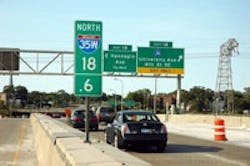35W bridge lacked redundancy
The kind of bridge collapse that shook Minneapolis and the nation last week almost happened a few years ago in Milwaukee. Suffering through a cold night and heavy truck traffic, the Hoan Bridge suffered a failure in three of its girders. The span, however, had redundancy, which in turn saved lives.
Most bridges designed and built over the last 30 years have redundancy, which prevents a bridge collapse if there is a fracture or failure suffered by a bridge member.
“The Hoan Bridge was inspected on a regular basis, but sure enough on a very cold night with a lot of heavy truck traffic there was a failure,” Ray McCabe, senior vice president and chairman, HNTB Bridge Services, told Roads & Bridges. “We learned a lot from the 1970s and ’80s and I don’t believe we see issue with our bridges designed after that point. But it is the bridges that were designed back in the beginning of the welded era where non-redundant bridges were quite often used. Welded construction also was used with very poor fatigue details, and all of this compounds itself to a bridge that needs a lot of attention.”
Built in 1964, it was clear that the 35W bridge in Minneapolis demanded special and immediate care after it spilled into the Mississippi River killing at least five motorists traveling the span during rush hour. “History will tell us that failures like that have generally been either scour, which I don’t think was the case [in Minneapolis], or some fatigue-related issue,” said McCabe. “I’m sure the investigation will focus on those two things, with probably more of it being on some fatigue-related issue.”
McCabe believes routine and visual inspection of bridges has served the industry and motoring public well over the years, but they are not the end-all solution to preventing a collapse like the one in Minnesota. The bridge engineer told Roads & Bridges that every fracture-critical bridge in the U.S. should experience sophisticated failure analyses.
“I think every bridge that is fracture-critical should be doing that, at least every bridge that is fracture-critical and in a high-volume area,” he said.
If a state DOT has a bridge that does not pass the failure analyses then, according to McCabe, “a study should be done to see what it would take to make that bridge redundant and at what cost.”
Improving the overall condition of bridges in the U.S. would take a substantial amount of money. Last week the House of Representatives passed a FY 2008 spending bill that would dedicate $40 billion to highway and bridge construction. President George W. Bush, however, threatened to veto the measure before the 35W bridge collapse.
“We know [$40 billion] is not even near a level of infrastructure funding that will get us anywhere.
“The public out there should be screaming bloody murder on the level of funding and how [the 35W bridge collapse] could happen,” added McCabe. Until a major funding bill is passed, the nation faces a mounting number of bridges in the same class as the 35W before it snapped.
“Do I sit here fully confident that we will not have bridge failures in the future? No. Could this collapse been expected? I can’t deny that,” said McCabe.
